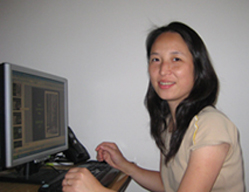Recent Events
- Wei Mo & Jiahuai Han: Gut stem c...
- Qiao Wu: Ectosomal PKM2 Promotes...
- Jing Yuan: A Protein Palmitoylat...
- Zhenghong Zuo: Black Phosphorus ...
- Jing Yuan: An intracellular memb...
- Qinxi Lin: c-Src Promotes Tumori...
- Shengcai Lin: AMPK and TOR: the ...
- Chundong Yu: Inflammation-induce...
- Shengcai Lin: Glucose Starvation...
- Xi Huang: Coordinated Transcript...
 Yi TAO, Ph.D.
Yi TAO, Ph.D.
Professor
TEL:+86-592-2180852
E-mail:yitao@xmu.edu.cn
1991-1996,Peking University, B.S., Plant Molecular and Developmental Biology, 1999-2004,The Scripps Research Institute, Ph.D., Macromolecular & Cellular Structure and Chemistry,
1999-2004, The Salk Institute, Postdoctoral Fellow
2007-present,Xiamen University,professor
Research Area
As sessile organism, plant has evolved the ability to cope with various biotic and abiotic stresses. Light serves not only as energy resource for plant, but also as an important environmental signal. It directs plant development throughout its whole life span. When sun plants are under canopy shade, they often display a set of responses that are collectively referred as the Shade Avoidance Syndrome (SAS). The main output of the SAS is re-allocation of energy resources towards elongation growth at stems and petioles, which allows the plant to compete for more light. Even though the SAS is beneficial to the fitness of individual plant, it causes reduction in crop yield due to reduced deposition to leaves and storage organs in shade-avoiding crops. In addition, plants displaying the SAS also exhibit higher disease susceptibility. We are interested in the molecular mechanisms of the light and the shade avoidance signal transduction pathway and their connections to plant disease resistance. Using model plant, Arabidopsis thaliana, we are working on identifying new components of light and shade avoidance signaling pathways through a combination of genetics, biochemical and molecular biology approaches. Our long term goal is to design crops that can be planted at high density and to increase crop yield and the efficiency of land usage.
Selected Publications
1.Moreno JE, Tao Y, Chory J, Ballaré CL. Ecological modulation of plant defense via phytochrome control of jasmonate sensitivity. Proc Natl Acad Sci U S A. 2009 24;106(12):4935-40.
2.Savaldi-Goldstein S, Baiga TJ, Pojer F, Dabi T, Butterfield C, Parry G, Santner A, Dharmasiri N, Tao Y, Estelle M, Noel JP, Chory J. New auxin analogs with growth-promoting effects in intact plants reveal a chemical strategy to improve hormone delivery. Proc. Nat. Acad. Sci U S A. 2008 105(39), 15190-5.
3.Tao Y., Ferrer JL. Pojer F., Hong F. Ljung K., Long J.A., Li L., Moreno J.E., Bowman M.E., Ivans L.J., Lim J., Ballare C.L., Sandberg G., Noel J.P., Chory J. Rapid synthesis of auxin via a new tryptophan-dependent pathway is required for the shade avoidance response of plants. Cell , 2008 133:164-176
4.Chen M.*, Tao Y.*, Lim J., Shaw A., Chory J. (2005) Regulation of phytochrome B nuclear localization through light-dependent unmasking of nuclear-localization signals. Curr. Biol. 12; 15(7):637-42.
5.Yin Y., Vafeados D., Tao Y., Yoshida S., Asami T., Chory J. (2005) A new class of transcription factors mediates brassinosteroid-regulated gene expression in Arabidopsis. Cell 120(2):249-59.
6.Tao Y., Xie Z., Chen W., Glazebrook J., Chang H.S., Han B., Zhu T., Zou G., Katagiri F. (2003) Quantitative nature of Arabidopsis responses during compatible and incompatible interactions with the bacterial pathogen Pseudomonas syringae. The Plant Cell 15:317-330.
7.Wu Y., Wood MD., Tao Y., Katagiri F. (2003) Direct delivery of bacterial avirulence proteins into resistant Arabidopsis protoplasts leads to hypersensitive cell death. The Plant Journal 33(1):131-7.
8.Chen W., Provart N.J., Glazebrook J., Katagiri F., Chang H.S., Eulgem T., Mauch F., Luan S., Zou G., Whitham S.A., Budworth P.R., Tao Y., Xie Z., Chen X., Lam S., Kreps J.A., Harper J.F., Si-Ammour A., Mauch-Mani B., Heinlein M., Kobayashi K., Hohn T., Dangl J.L., Wang X., Zhu T. (2002) Expression profile matrix of Arabidopsis transcription factor genes suggests their putative functions in response to environmental stresses. The Plant Cell 14(3):559-74.
9.Tao Y.*, Yuan F.*, Leister R.T., Ausubel F.M., Katagiri F. (2000) Mutational analysis of the Arabidopsis nucleotide binding site-leucine-rich repeat resistance gene RPS2. The Plant Cell 12(12):2541-2554.